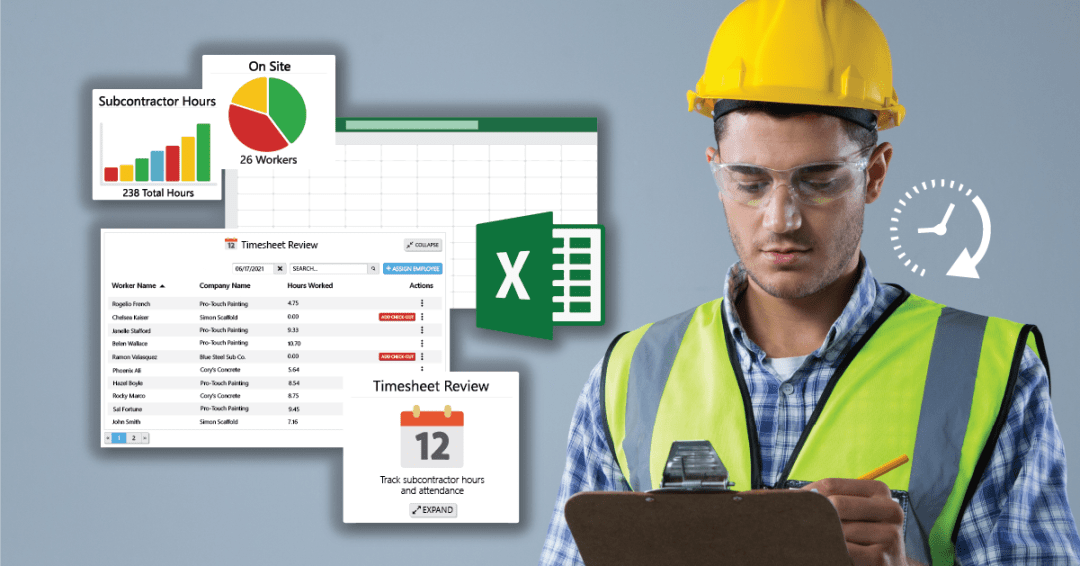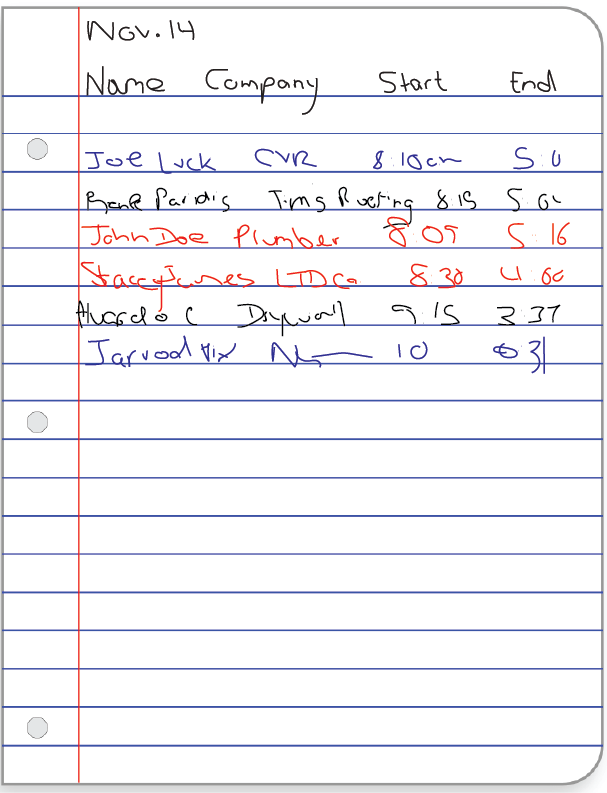There are a variety of ways that contractors can record time and attendance on construction sites. Some time and attendance systems are as simple as manual recording, and others can be sophisticated systems built to automate the collection of on-site time and attendance records.
No matter the tactics used to record time and attendance information, some different solutions and strategies make sense based on each company’s unique needs. This article explores the several types of time and attendance systems used in the construction industry.
Table of Contents (Click to Jump to Each Section):
Time & Attendance Systems: Manual Tracking Methods
The collection of time and attendance information in construction is not always a complex system. Employers often keep a close eye on time and attendance-related information for payroll purposes and do so by recording attendance manually on-the-job This increases the chance of human error or inaccuracies in the data collected, but for many contractors, this information is a sufficient start.
Here are several ways that contractors are recording time and attendance manually on the jobsite:
Manual Method 1: Paper Attendance Sheets
Sign-in sheets are still used on the jobsite in many instances, and although they have obvious limitations, they are more effective than having no time and attendance record-collection. Ever signed a guest book at a wedding or celebration? This is a similar concept and involves workers signing in and out on a paper timesheet at a designated check-in/out point.
This method relies heavily on the workers to complete this manual task to stay relatively accurate. It also assumes that workers are participating in the task daily, which can be a difficult expectation to set. Construction workers and companies are often in-and-out of the site quickly or are dealing with a variety of tools/equipment when entering the jobsite.
In some cases, there might be a site administrator or a security guard checking the arrival of workers on-site. This individual could have the sole task of ensuring that all workers who enter and leave the site and reporting to them and recording these events.
Whether a paper attendance sheet is tended to or not, this time and attendance system surfaces obvious data inaccuracies. If your payroll strategy relies on a manual system, you are more than likely not paying out precise time for workers on-site.
Paper Time & Attendance Sheets – Pros:
• Easy to set up
• Simple concept for the workers to understand
• Cost-effective (in the short run)
Paper Time & Attendance Sheets – Cons:
• Challenge to get accurate records
• Can be forged, cheated, or misleading
• Can be lost, misplaced
• Relies on admin work for data entry into payroll or other systems
• Manual, labor-intensive, and lacks automation
• Costs more in overhead/labor in the long run
• Not innovative
Manual Method 2: Excel Spreadsheets
Excel spreadsheets are a more efficient, and much more organized manual method to tracking time and attendance. This manual method involves either admin entry for workers showing up to site, or the participation of workers entering their attendance information into a computer on a spreadsheet. The introduction of a computer into the attendance record process can present a further challenge for construction workers.
Time and attendance recorded on a spreadsheet might lead to simpler entry, however, the same challenges that impact paper attendance sheets exist:
• Method relies heavily on the workers to complete this manual task and ensure accuracy
• Assumes worker participation
• Relies on some form of administration to manage, enter, or oversee data
The construction industry is a fast-paced, chaotic world and a project could see the exchange of hundreds of workers on a site each day. Accurate data on-site traffic, subcontractor attendance, and specific worker timecards can lead to better decision-making and provide conclusive answers for the firm managing the site.
Spreadsheet Time & Attendance Sheets – Pros:
• Easy to set up
• Simple concept for the workers to understand
• Cost-effective (in the short run)
• More organized than paper time & attendance
• Easier to export/import data to external systems
• Widely understood software
Spreadsheet Time & Attendance Sheets – Cons:
• Challenge to get accurate records
• Can be forged, cheated, or misleading
• Relies on admin work for data entry into payroll or other systems
• Manual, labor intensive, and lacks automation
• Costs more in overhead/labor in the long run
Why Manual Time & Attendance Systems Do Not Work (Well Enough)
The process of tracking construction workers’ time and attendance on a site is no easy task. There is a lot of movement, and involvement to ensure proper data collection that the organization recording the data can rely on.
The main reasons why manual time and attendance systems are unreliable:
1) Time Theft
When workers are required to mark their own attendance on a jobsite, there are ways around providing accurate time entries. Some workers will inevitably find their way around data entry to ensure their pockets are filled. Even if all timesheet information is audited, the audit process can miss invalid entries and can take a significant amount of time to sort out.
2) Risk of Human Error
Any manual process allows for human error. If a trusted resource is manually recording time and attendance information, there is still a chance that the individual will make a mistake.
3) Time Consumption
There is a lot of overhead involved with any manual process, and in this case, there would be a significant amount of time spent on data review and cleaning up an entry before payroll starts.
4) Outdated
It is 2021, there are simply more efficient ways to record time and attendance information that does not break the bank and offer instantaneous ROI.
5) Storage of Historical Data
Want to reference time and attendance information from 2 years ago on a specific day? You will be surprised how often you may need older time and attendance data. Whether it be dealing with a legal matter, or just referencing past project workforce data to forecast upcoming work; you will eventually benefit from historical data.
Manual methods are easier to implement and, in many cases, cheaper at face value. But if you dig into the economics behind reliable time and attendance data, you will understand that there is ROI from investing in an automated system.
When you rely on time and attendance data for payroll, regulatory compliance, or any other processes that require accurate information you should be considering a comprehensive system that automates much (or all) of the data entry process.
Time & Attendance Systems: Automated Tracking Methods
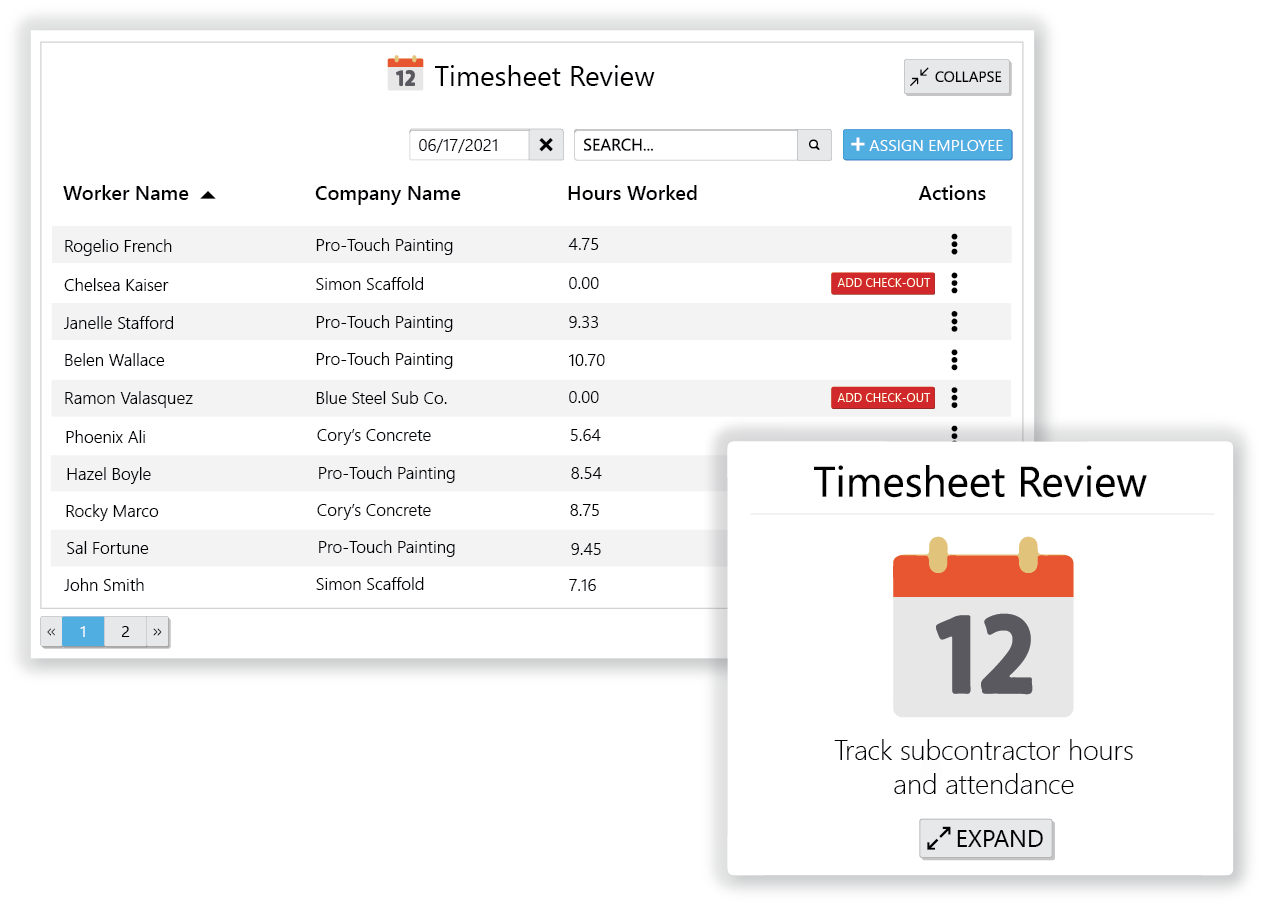
(Pictured: myComply’s Automated Time & Attendance Feature Within Projects Pro)
As technology becomes more sophisticated, automating the time and attendance process gets more realistic for construction firms. Construction companies around the world have adopted technology increasingly each year, and show no signs of slowing tech-adoption. This includes time and attendance systems built for construction sites.
Construction projects are starting to become equipped with all types of technology to help with more accurate data collection, data management, and data analysis. Time and attendance technology is innovative and offers a way for contractors using manual processes to explore automated data collection/entry.
Here are some of the several types of automated time and attendance systems utilized on construction sites across the globe:
Automated Method 1: Mobile Time and Attendance System
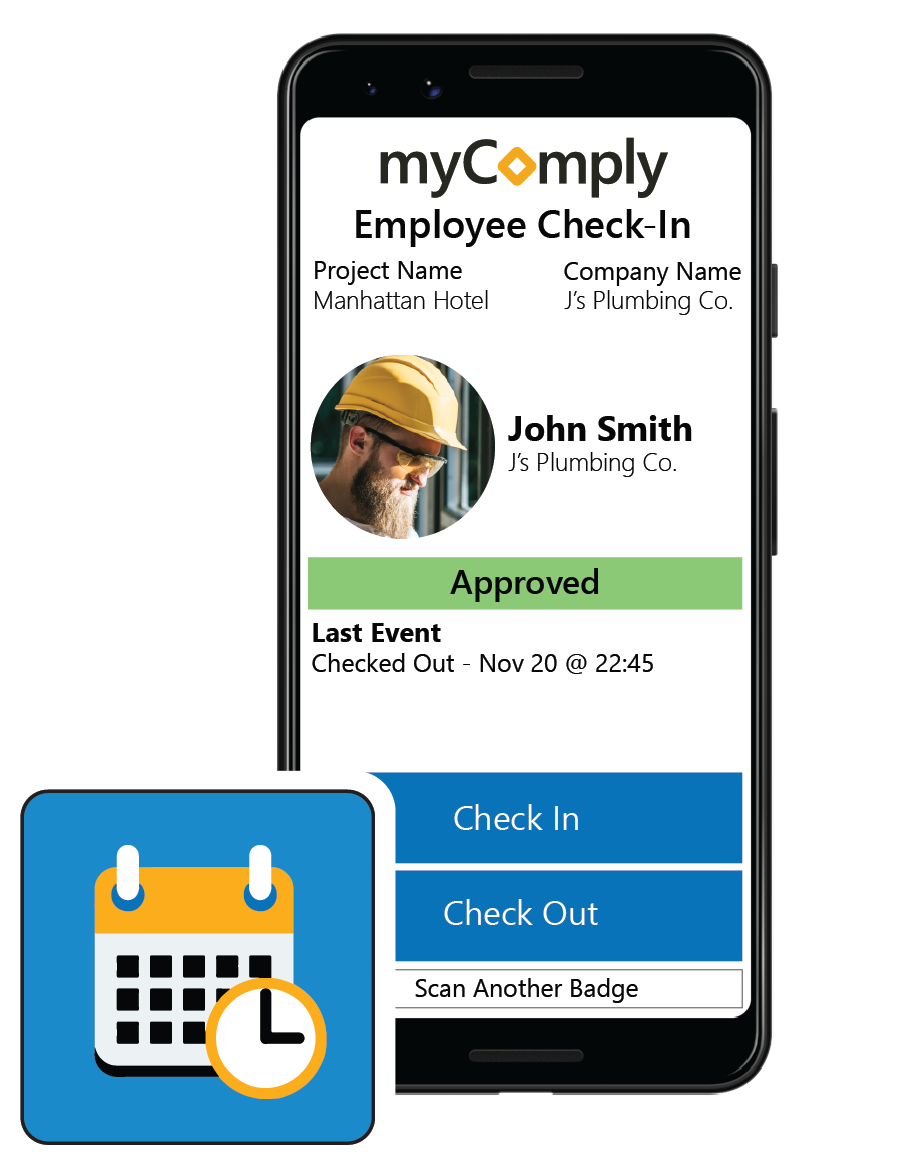
Mobile time and attendance solutions are more popular on jobsites than they were as little as 5 years ago. Why? More construction workers are carrying a smartphone in their pockets.
Mobile time and attendance systems offer simple check-in (or clock-in) and check-out functionality. A worker arrives at the site and starts their shift by clocking their arrival on the mobile app. At the end of their shift, they access the application and check-out for the day of work. This allows payroll admins and other staff to rely on worker hours to access the information without having to do any data entry.
Smartphone solutions work great when all workers are willing to take responsibility and get involved with their personal smartphones. However, this is not always the case in construction. Some workers are not willing to use their private property for work purposes, and in some cases, workers may not have access to a smartphone. Mobile time & attendance solutions are not entirely inclusive and have the potential of squeezing out otherwise qualified workers.
Mobile Time & Attendance Apps – Pros:
• Simple user experience, easy-to-use
• Data entry is done at the worker level, less admin time
Mobile Time & Attendance Apps – Cons:
• Rely on every worker to use their own smartphone
• Rely on every worker to have a smartphone
• May rely on location tracking of the worker to verify they are on-site
• Technology can be a challenge to implement
Automated Method 2: Geofencing Time & Attendance System

(Pictured: Geofenced sites are connected to worker’s mobile phone location, allowing the site to detect who is within site perimeter and who is not – AllGeo)
Geofenced sites are those where a perimeter location is tracked and always monitored. The location of workers on the site can be referenced and tracked so long as the worker has allowed location tracking from their smartphone device. Once allowed, worker location and time are tracked whenever that worker steps within the perimeter. When the worker steps foot outside of the perimeter, their time and attendance info is paused or stopped.
This can provide extremely detailed data and accurate attendance reports. However, this system does not come without similar challenges to a mobile app solution. A major problem with geofenced time and attendance systems is that, once again, all workers must have, and be willing, to use their mobile phones.
Furthermore, the notion of a geofenced time and attendance system is often viewed by workers as a “Big Brother” concept. Construction workers are hesitant to adopt the idea of location tracking and the concept that their employer always knows their exact location. Although location tracking can be a benefit for safety purposes, time and attendance, or other solutions, it carries the stigma of constant surveillance.
It can be difficult to get any ROI from your investment if nobody is willing to use the system. Successful implementation of technology involves buy-in and participation. Let us explore where geofenced time and attendance works well, and where it falls short.
Geofenced Time & Attendance Apps – Pros:
• One of the most accurate data collection processes
• Extremely automated
• Can be set-up anywhere
Geofenced Time & Attendance Apps – Cons:
• Rely on every worker to use their own smartphone
• Rely on every worker to have a smartphone
• Heavily relies on location tracking of the worker to verify they are on-site
• Hesitancy behind “Big Brother” concept of time and attendance
• Technology can be a challenge to implement
• 17% of those who use geofencing experienced consistent problems
• Drains smartphone battery life significantly
Automated Method 3: Integrated Access Control Time & Attendance System
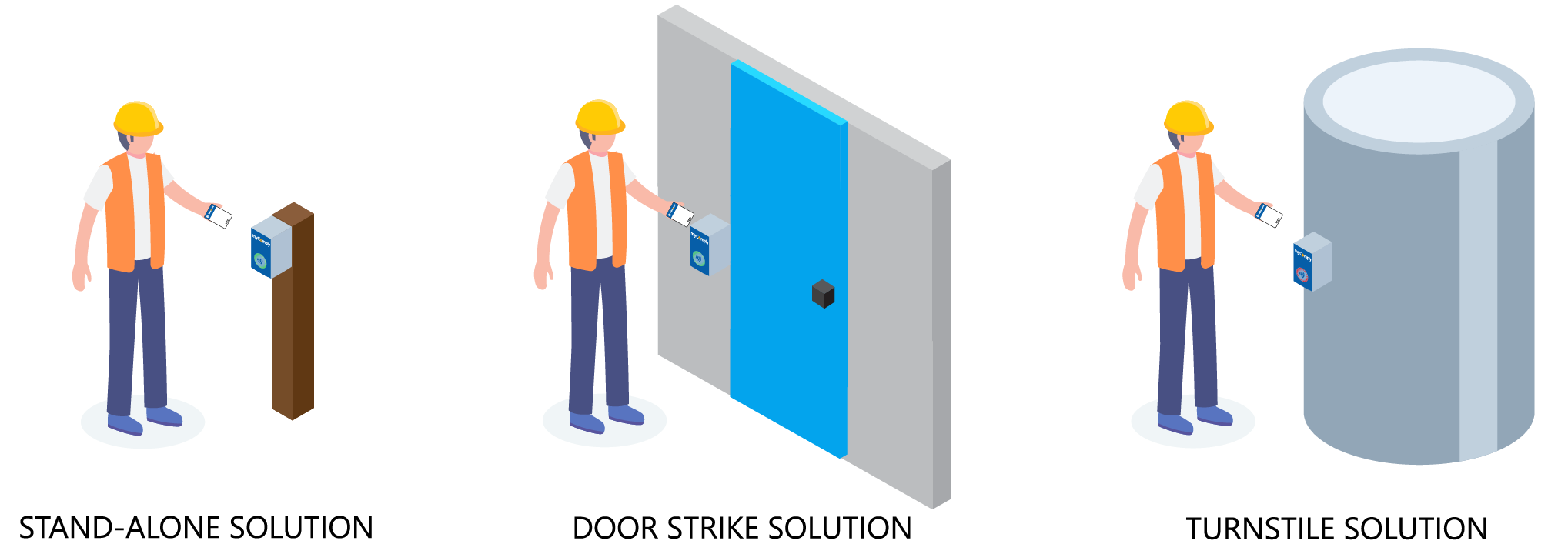
(Pictured: Geofenced sites are connected to worker’s mobile phone location, allowing the site to detect who is within site perimeter and who is not – AllGeo)
Access control systems are not exclusive to the construction industry; however, they play an extremely important role in protecting high-risk construction sites. Access control solutions like a turnstile, or locked door keep unwanted trespassers or unauthorized individuals off the jobsite.
Workers looking to access a construction site using access control solutions typically need some form of ID badge or fob to enter site. Tapping a badge or fob to a locked turnstile or door grants your workforce access to the site. A system like this provides extremely detailed data while also ensuring that only qualified individuals access the site.
Time and attendance systems that integrate with access control solutions offer a variety of benefits to site owners, or general contractors running the site.
Access Control Generated Time & Attendance – Pros:
• Only authorized workers are logging hours
• Designated entry/exit points allow for reliable data
• Extremely automated
• Can be set-up anywhere
• Integrated with external systems and software (Procore, Autodesk, etc.)
• Does not rely on worker’s personal smartphone
• Highly customizable for every site’s specific needs
• Does not always track worker location
Access Control Generated Time & Attendance – Cons:
• Rely on site perimeter to be gated or closed
• Needs some form of admin involvement
• Logistical challenges to coordinating
Conclusion: Why Automating Your Time & Attendance System Will Positively Impact Your Business – And Your Bottom Line
Ensuring an automated time and attendance system on your construction site means better data overall, less administrative intervention, and reliable information for business processes like administering payroll. Choosing the right automated time and attendance system for your construction site is entirely up to you, as every site has a unique set of requirements.
In large urban metro areas, we see the need for full access control solutions to keep passerby traffic and trespassers from accessing high-risk sites. In rural areas, there may be less of a need to secure the worksite and a mobile solution might work well.
The big differentiator between an automated system and something that takes place manually is the overhead and time spent performing manual work. Administration of a manual system will inevitably cost your business more in the long-run and will not provide the same level of data integrity. If you are a business that relies on data to make informed decisions, you are going to get a lot more out of an innovative technology that you invested in than the scribbled signatures of workers who arrived on your jobsite.
Automated time and attendance systems may take more involvement to implement, but once the solution is understood by internal stakeholders, these systems are built to run without manual efforts. Data you collect will be detailed, highlight trends, and give you a better understanding of work performed on your site(s).
Here’s where automated time & attendance impacts your bottom line:
- More accurate payroll information
- Less chance of time-theft, inflated hours, and/or illegible attendance information
- Less manual work and admin time
- An automated system performs a lot of the work that a data admin or project admin would do regarding data collection, organization, and payroll administration.
- Historical events or attendance events to avoid compliance-related fines
- If an auditor or legal obligation requires an understanding of whether a worker was present on the job vs. not present your automated system should be capable of storing historic information, detailed to days, hours, projects, etc.
- Better decision-making
- Misinformed or assumptive decision-making can lead organizations down the path of making the wrong conclusion/decision.
When looking to gather time and attendance information on your next project, be sure to consider all your options. A solution might be a great fit for one of your small-scale projects but not work for a larger job. Each project should have a detailed needs analysis to understand what will work and what will not before implementing any automated system.
Implementation Success Starts with Buy-In & Enforcement
Time and attendance systems will NOT work unless they are enforced, and the workforce is bought-in to using the system. To have true automation on the jobsite, workers will have to participate in the process in some form or fashion.
The question that many solution providers get is,
“But what if my people don’t do this? What if my people don’t use this system?”
Our answer is simple, the system works as well as you want it to. When adopting any system that provides a level of automation, there is manual work to start and enforcement of behaviors to ensure the solution is working properly. To get accurate time and attendance information, your time and attendance solution must be used by all workers on the job.
Workers will have to interact with any time and attendance system, no matter which solution. A mobile app system requires personal smartphone use, a geofenced system requires RFID badges to be always worn, and an access control system requires an ID badge to access a site. Your workers and site staff will have to buy-in to the system of your choice for it to work effectively.
It is best to keep this in mind when determining which solution works best on your construction site(s).
Looking for help determining what time of time and attendance system you need?
Our team will work with you to understand your site-specific requirements and suggest a solution that will work for you. We are here to help! Click the link below to book a short 15-minute call to explore your options with an experienced member of our team.

